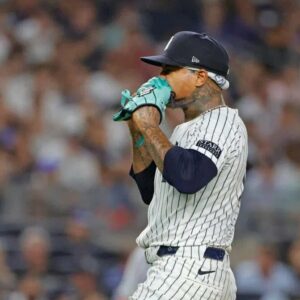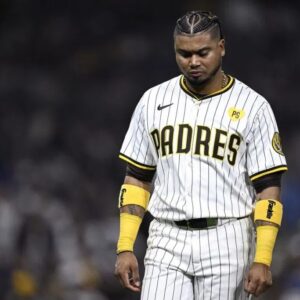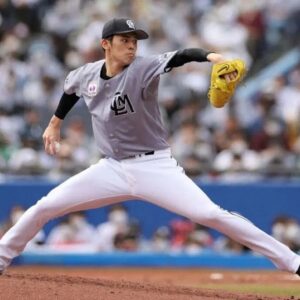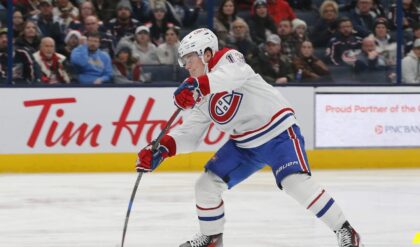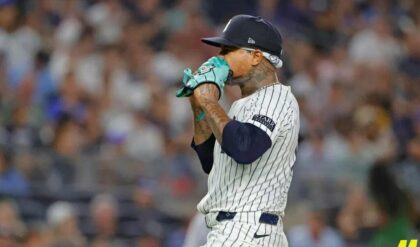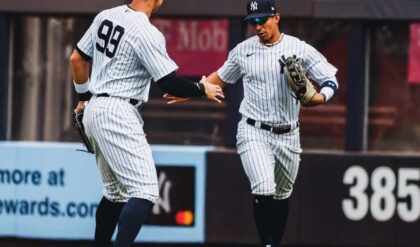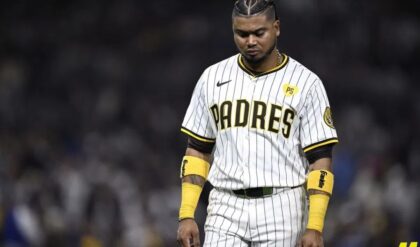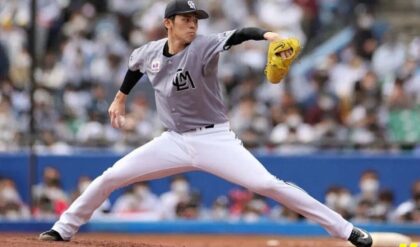
The New York Yankees’ infield landscape is undergoing a significant transformation as the 2025 season approaches. At the heart of this evolution stands Oswaldo Cabrera, who could emerge as the team’s primary third baseman. This development represents both a strategic pivot and a vote of confidence in the young infielder’s capabilities.
Since making his major league entrance on August 17, 2022, Oswaldo Cabrera has established himself as an invaluable Swiss Army knife for the Yankees. The 25-year-old Venezuelan, measuring 180 cm and weighing 90 kg, brings exceptional defensive versatility to the roster. His ability to seamlessly transition between second base, shortstop, and all outfield positions has made him an indispensable asset during roster disruptions and strategic adjustments.
During the 2024 campaign, Cabrera demonstrated steady development, posting a .247 batting average complemented by 8 home runs and 36 RBIs across 109 appearances. While his offensive numbers suggest room for growth, his defensive excellence shines through in the metrics. A career total of 9 defensive runs saved at third base underscores his natural aptitude for the hot corner.
Infield evolution: The shifting Yankees landscape
The consideration of Cabrera for third base duties emerges amid broader infield restructuring. The addition of Jazz Chisholm Jr. has precipitated a strategic realignment, with the dynamic newcomer expected to return to his natural second-base position. This reconfiguration opens a pathway at third base, where Cabrera stands as a prime candidate to assume regular duties.
The Yankees’ skipper, Aaron Boone, has expressed particular enthusiasm about Cabrera’s potential in this role, emphasizing his defensive prowess and remarkable adaptability as key attributes supporting this transition.
LeMahieu’s situation hands Cabrera third base role
 Joey@X
Joey@X
The uncertainty surrounding DJ LeMahieu’s status has accelerated the need for alternatives at third base. LeMahieu’s challenging 2024 season, marked by a modest .204 batting average, 2 home runs, and 26 RBIs in 67 games, raised concerns about his durability. A right hip impingement that sidelined him in September and kept him off the postseason roster has prompted the Yankees to explore contingency plans.
While LeMahieu’s veteran presence remains valuable, the combination of health concerns and performance regression has necessitated a proactive approach to third-base staffing, with Cabrera emerging as a compelling solution.
Strategic factors behind Yankees’ decision
 AP
AP
Several strategic elements influence the Yankees’ inclination toward Cabrera as their third base solution:
Development Philosophy: The potential promotion aligns with the organization’s renewed emphasis on nurturing internal talent, demonstrating a commitment to player development and organizational sustainability.
Economic Efficiency: Utilizing Cabrera as the primary third baseman presents a cost-effective solution, enabling resource allocation toward other roster needs, particularly pitching and outfield depth.
Market Dynamics: The limited availability of elite third basemen in both trade and free agent markets makes internal solutions more attractive, despite occasional speculation about potential targets like Alex Bregman.
Positional Flexibility: His multi-position capabilities provide invaluable roster flexibility, offering coverage across multiple positions even if he settles primarily at third base.
The third base solution: Analyzing Cabrera’s fit
 AP Photo/Seth Wenig
AP Photo/Seth Wenig
Cabrera’s potential installation at third base could enhance the Yankees’ defensive alignment while maintaining crucial lineup flexibility. His demonstrated ability to handle multiple positions provides manager Aaron Boone with tactical advantages in managing injuries, rest days, and matchup-based decisions.
Risks and rewards
 AP Photo/Adam Hunger
AP Photo/Adam Hunger
The promotion of Cabrera to everyday third baseman carries both opportunities and challenges:
Potential Challenges
Offensive Development: While showing promise, Cabrera’s 2024 offensive numbers indicate room for improvement. Consistent production at the plate will be crucial for long-term success.
Durability Questions: The transition to full-time third-base duties represents a new physical demand, requiring careful management of workload and recovery.
Utility Trade-off: Focusing Cabrera at third base might limit his valuable multi-position flexibility that has benefited the team’s roster construction.
Performance Pressure: The demands of regular playing time in New York’s demanding environment will test the utility star’s mental fortitude.
Expected Benefits
Defensive Excellence: Cabrera’s impressive defensive metrics suggest the potential for elite third-base play, strengthening the Yankees’ infield defense.
Resource Optimization: The internal solution allows for strategic resource allocation to other roster needs.
Player Development: Regular playing time could accelerate Cabrera’s development into a more complete player.
Organizational Culture: The promotion of homegrown talent reinforces the Yankees’ commitment to player development.
Tactical Advantages: Despite a primary third base role, the utility star’s positional flexibility remains a valuable tactical asset.
Looking ahead
The Yankees’ consideration of Oswaldo Cabrera as their primary third baseman reflects a thoughtful balance of present needs and future potential. His combination of defensive excellence, positional versatility, and developmental upside presents an intriguing solution to the team’s third base question.
While challenges exist, the potential benefits of entrusting Cabrera with regular third-base duties align with both immediate competitive goals and longer-term organizational strategy. As the Yankees pursue excellence in 2025, Cabrera’s evolution at third base could prove pivotal in their championship aspirations, demonstrating the value of patient player development and strategic roster management.
What do you think? Leave your comment below.
News
Martin St-Louis refused to punish Cole Caufield for his dumb penalty.
If there is one player who steps up in Patrik Laine’s absence, it’s Cole Caufield. Caufield, who scored three goals in 13 games while Laine was in uniform, has just scored three in his last three games – the three…
Yankees facing an uphill task to offload Marcus Stroman, bullpen role in the offing
The New York Yankees find themselves in an intriguing predicament as they evaluate their options regarding veteran hurler Marcus Stroman. As the 2025 season approaches, the organization faces the delicate task of managing an overflow in their starting rotation. While most…
Yankees persist in pursuit of Luis Arraez trade as talks continue, reports insider
The New York Yankees have been actively working to bolster their infield ahead of the 2025 season. According to ESPN’s Jeff Passan and confirmed by Yahoo, the Yankees have “continued to discuss” a trade with the San Diego Padres for infielder Luis Arraez….
Insider shoots down reports of Yankees move for Luis Arraez: ‘Not seen as a fit’
In an offseason marked by significant roster reconstruction, the New York Yankees appear to be stepping back from trade discussions involving Padres infielder Luis Arráez. Despite their pressing need for a second baseman, recent indicators suggest the Yankees have determined Arráez…
Roki Sasaki race: Yankees frontrunners along with Padres, claims insider
The baseball world’s attention has focused intensely on the impending decision of Japanese pitching phenomenon Roki Sasaki, with the New York Yankees emerging as a leading contender for his signature. The 23-year-old phenom has attracted serious interest from multiple MLB organizations,…
Aaron Judge earns iconic status as Topps’ 2025 Series 1 ambassador
Topps has bestowed one of baseball card collecting’s highest honors upon New York Yankees captain Aaron Judge, naming him the face of their 2025 Series 1 Baseball collection. Following an exceptional 2024 campaign, Judge’s selection was revealed through an elaborate announcement that…
End of content
No more pages to load

